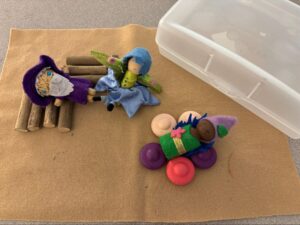 This blog post was written by NCTE member Christy Hermann Thompson as part of a blog series celebrating the National Day on Writing®. To draw attention to the remarkable variety of writing we engage in and to help make all writers aware of their craft, the National Council of Teachers of English has established October 20 as the National Day on Writing®. Resources, strategies, and inclusion in a blog post does not imply endorsement or promotion by NCTE.
This blog post was written by NCTE member Christy Hermann Thompson as part of a blog series celebrating the National Day on Writing®. To draw attention to the remarkable variety of writing we engage in and to help make all writers aware of their craft, the National Council of Teachers of English has established October 20 as the National Day on Writing®. Resources, strategies, and inclusion in a blog post does not imply endorsement or promotion by NCTE.
As the school year gets rolling in elementary classrooms across the country and our schedules and routines start to take shape, many teachers find that writing time feels a little squished. (Heck, the whole day may feel a little squished this time of year!) And yet, when we slow down enough to listen to the students in front of us, we get to know them both as writers and people. These precious moments of listening in our day not only help us plan responsive writing instruction but also allow us to build our writing community.
Here are two places I’m making space for listening to the writers in my first-grade classroom.
Storytelling Boxes: Listening to Narrative Play
Many children (and adults) naturally play in the narrative arc. Their knowledge of fictional elements—character, setting, problem, and solution come out on the playground and in the toy box. My friend and colleague Katie Keier inspired me to capitalize on this ability and further develop it by using storytelling boxes with my students. Each pencil box contains a “setting” (square of fabric), some “characters” (various figurines, small animals) and some “loose parts,” (small rocks, fake flowers, beads, spools).
 After some brief instruction in the first week of the school year demonstrating the variety of stories that could be invented from the same box, the first graders were off and running. This short time in our day provides an amazing opportunity for listening. I ask questions such as, “Oh, how would you describe this character?” or “What will this character say next?” or “How will they solve that problem?” These kinds of prompts can encourage children to craft a story through their play, but often, all I need to do is listen. When I do, I learn so much about their oral language, vocabulary, ideas, preferred stories and movies, and more.
After some brief instruction in the first week of the school year demonstrating the variety of stories that could be invented from the same box, the first graders were off and running. This short time in our day provides an amazing opportunity for listening. I ask questions such as, “Oh, how would you describe this character?” or “What will this character say next?” or “How will they solve that problem?” These kinds of prompts can encourage children to craft a story through their play, but often, all I need to do is listen. When I do, I learn so much about their oral language, vocabulary, ideas, preferred stories and movies, and more.
And then, this knowledge can inform my writing instruction. For example, I might start a writing lesson with, “The other day Yoshu created a story with her storytelling box that had a problem in it! The evil bunny stole the tiger’s gems. When an author includes a problem in her story like that, it makes it really interesting to read. Today we can try including a problem in the middle of our stories like Yoshu. Let me teach you how to do that.” As we continue to use storytelling boxes this year, I am changing out the materials to match the content we are reading and learning about, giving them opportunities to practice using new vocabulary in the context of play. For example, we are currently reading about and studying how animals and plants grow and change. The characters in our storytelling boxes have been swapped out for tadpoles, frogs, caterpillars, butterflies, and more. Their stories are already brimming with new ideas and language, and I am eager to listen.
writing lesson with, “The other day Yoshu created a story with her storytelling box that had a problem in it! The evil bunny stole the tiger’s gems. When an author includes a problem in her story like that, it makes it really interesting to read. Today we can try including a problem in the middle of our stories like Yoshu. Let me teach you how to do that.” As we continue to use storytelling boxes this year, I am changing out the materials to match the content we are reading and learning about, giving them opportunities to practice using new vocabulary in the context of play. For example, we are currently reading about and studying how animals and plants grow and change. The characters in our storytelling boxes have been swapped out for tadpoles, frogs, caterpillars, butterflies, and more. Their stories are already brimming with new ideas and language, and I am eager to listen.
The Literary Magic of Cat Barf: Listening to Kids Write About . . . It All
As teachers we sometimes have an internal set of rules regarding what topics are “okay” to write about and those that are not. Students writing nonfiction texts about animals? Yes, acceptable. Students writing nonfiction texts about animal poop? Not so much. Students writing their own version of a fairy tale? Yes. Students writing their own version of a Marvel movie? Not usually. But what happens to student engagement when we act as the non-negotiable gatekeeper of the topics we can write about? Or even more limiting, what if we are always giving children a writing prompt and everyone has to stick to that topic? When we make these decisions, we undoubtedly squash individual voices and devalue the diversity of lived experiences in our classroom. And the beautiful truth is that if we come alongside children and really listen to what our writers are telling us, we will find they have the material to write vociferously and passionately about self-chosen topics while also achieving our curricular standards. I have learned through listening that the ins and outs of Minecraft can produce a complex explanatory text. I have learned through listening that a story about cat barf can inspire an engaging narrative text with a beginning, middle, and end. I have learned through listening that I can teach the difference between common and proper nouns using Paw Patrol character names. Most importantly, I have learned by listening to my writers that they are proud of their homes, their interests, and their lives outside of school. Writing instruction can be rigorous, high-level, and still honor those funds of knowledge (Moll, 1992).
Listening to the young writers in our classroom is critical. It helps us know what to teach next and, perhaps more importantly, it helps us know who our students are. Where do you make space to listen to writers in your classroom?
Reference:
Moll, Luis C. 1992. “Bilingual Classroom Studies and Community Analysis: Some Recent Trends.” Educational Researcher 21 (2) 20–24.

Christy Hermann Thompson is currently a first grade public school teacher near Washington, DC. She has worked as a literacy coach, reading teacher, and preK–2nd grade teacher. Christy is the coauthor of the book Hands Down, Speak Out, about student-led conversation in literacy and math. Connect with her on her blog or Instagram.
It is the policy of NCTE in all publications, including the Literacy & NCTE blog, to provide a forum for the open discussion of ideas concerning the content and the teaching of English and the language arts. Publicity accorded to any particular point of view does not imply endorsement by the Executive Committee, the Board of Directors, the staff, or the membership at large, except in announcements of policy, where such endorsement is clearly specified.

